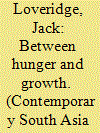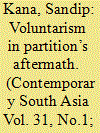| Srl | Item |
| 1 |
ID:
152350


|
|
|
|
|
| Summary/Abstract |
Built from the ground up by three thousand Sikh and Hindu refugees in the aftermath of the Partition of India in 1947, the town of Nilokheri in East Punjab emerged as an unlikely centre of agricultural education and scientific exchange. With support from the Ford Foundation, Indian and American scientists and development planners worked through the 1950s to transform the refugee township into a model of agricultural innovation and community development. Prime Minister Jawaharlal Nehru even cast Nilokheri as the first step on the ‘road to new India’ that would bring the nation to self-sufficiency in food production. Over the course of a decade, experimental farms, workshops, and agricultural training centres rose around the village. The bustling town rapidly became an internationally recognised centre for deploying new farming technologies, training farmers, and sharing scientific knowledge. Yet for all its initial promise, allegations of bureaucratic mismanagement dogged the project, floodwaters disrupted the site in 1957, and Ford’s interest shifted by the early 1960s. The Nilokheri experiment, however, set the stage for the scientific and social interventions of India’s Green Revolution, contributing to an international development paradigm that persists today.
|
|
|
|
|
|
|
|
|
|
|
|
|
|
|
|
| 2 |
ID:
192296


|
|
|
|
|
| Summary/Abstract |
This article adopts an alternative framework for thinking about the Nehruvian state and the drivers that shaped India’s postcolonial development strategy. This is a firm shift away from viewing development as a technocratic enterprise, and towards a focus on how the Nehruvian state sought to deploy notions of voluntarism. Within the Indian context, voluntarism referred to the mobilisation of ordinary people to further local development projects. This article investigates voluntarism through efforts at rehabilitating able-bodied refugees in Faridabad. Like many refugee townships that were constructed in the immediate aftermath of Partition, Faridabad was built from the ground up entirely through reskilled able-bodied refugee labour. Within the environment of rehabilitation, the article shows how voluntarism through the cooperative model became an integral postcolonial development strategy adopted by the Nehruvian state to construct new distinct urban spaces on formerly uncultivated lands. However, the article will reveal how the Nehruvian state’s use of voluntarism was beset with tensions, challenges, and problems. The article shows how widespread refugee discontent, bureaucratic mismanagement and alleged financial misconduct ultimately impeded the Nehruvian vision of empowering and mobilising ordinary Indians to further projects of public utility.
|
|
|
|
|
|
|
|
|
|
|
|
|
|
|
|